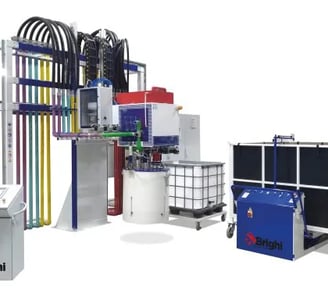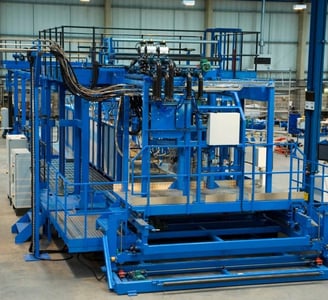Spray Coating Foam Line


Composite spray molding technology is essential for an efficient coating process, providing a remarkably uniform and reproducible distribution of polyurethane. This uniformity is crucial for minimizing warping and decreasing the overall material usage, which in turn lightens the final product. The process begins with the fiber semi-finished products being wetted on one or both sides with a thermally activated polyurethane system using a spraying technique. The curing occurs rapidly in a heated press mold, typically within 45 to 90 seconds, allowing for increased productivity. Moreover, the technology effectively eliminates the use of solvents through the implementation of self-cleaning spray nozzles, promoting a more environmentally friendly operation. As a result, composite spray molding technology not only enhances efficiency but also delivers high-quality composite parts suitable for various applications.
Composite Spray Molding Technology
It is indispensable for an efficient coating process. It offers the particular advantage of an extremely even and reproducible distribution of the polyurethane, which is important in terms of warping and also reduces the amount of material required and thus the weight of the part. Regardless of the type of reinforcement, the Fiber semi-finished products are first wetted with a thermally activated PU system on one or usually both sides using the spraying technique. The thermal activation in a heated press mould enables curing within 45 to 90 seconds. By completely eliminating the need for any type of solvent and using the self-cleaning spray nozzles, spray technology not only substantially reduces production costs, but also greatly facilitates the use of extraction systems during production. Furthermore, time and energy intensive heating processes are not required.
Metering Machine
A high-pressure metering machine for manufacturing parts is equipped as standard with two sized metering pumps, each with an output of 65 cm³/s. This configuration is based on a typical total material output of 50 cm³/s. Other standard features are frequency control for automated output adjustment and magnetic couplings for the pump drive sealing to prevent leaks and the need for maintenance. In addition, there is a gear counter to measure the flow rate and a control cabinet cooling system to ensure stable production even at high temperatures. Depending on the cycle, the machine has two metering pumps to spray homogeneously from above, or four metering pumps which allow simultaneous spraying from above and below. This cuts the cycle time for one part in half.
Mix Head
A specially developed spray mix head In Mixing process. Pressure and temperature sensors are located close to the mix head and their parameters are continually assessed by the control system. The mix head is supplied with the constant pressure injectors that keep the pressure stable in a certain operating window and also during changes in the flow rate.
A circular jet spray nozzle is used for the atomization of the PU mixture. This produces a uniform distribution of the mass and an equal distribution of weight in the part. Targeted spraying of the PU mixture can additionally reduce the material usage.
The mix head is located in a balancer attachment (a lifter) which is completely integrated into the roof of the booth. This effectively minimizes contamination during spraying. The lifter can be easily moved downwards for maintenance. A servo motored glass chopper can be mounted in the lifter for local reinforcement using chopped glass feeding, this cuts the rovings as required and introduces them into the polyurethane jet stream. If required, a second mix head can be used to spray from underneath. This additional mix head is located in a rear-mounted mix head manipulator.
Tank Assemblies
Double-walled 250l steel tanks are used for conditioning the PU
components polyol and isocyanate. The tanks include a stirrer which is fitted with a magnet coupling on the isocyanate side. A microwave continually measures the tank filling level. A temperature control unit for heating and a plate heat exchanger for cooling are also installed as standard. The tanks are supplied with dried compressed air using a compressed air dryer. Insulated tanks and motor-driven edge filters are available. A further option is a stainless steel tank which may
be required for the raw material system. A refilling solution for the drums or IBCs can be selected for filling the tanks with the material. It also provides complete tank farm solutions for large- scale production.
Gripper
The gripper is used to collect and transport the sandwich panels into the spray booth. Both manually adjustable grippers and automatic grippers are available and each is firmly attached to the robot.
The gripper is open on one side and grips using a pneumatically-driven clamping mechanism. The continuously adjustable manual gripper is particularly useful in laboratory applications or for producing multiple identical parts. In contrast, the automatic gripper allows a production mix because it can be quickly adjusted with the servo motor for the production of different parts. Alternate parts with different dimensions can thus be produced on plant systems with two presses, for example.
Robot
A robot made by the company comes as a standard feature for handling the gripper and for quick and secure movement along the production line. The robot has an operating radius of 3.2 metres with a maximum load capacity of 150 kg. The extensive range means that large sandwich surfaces can be sprayed, not only for big parts but also for producing several parts in multiple cavities. The robot is completely integrated into the plant control system.
Feed table
The feed table is used for collecting and positioning the sandwich panels. It operates in coordination with the gripper type and dimensions and can take up different sized sandwich panels without being modified. A sandwich panel recognition system is directly integrated into the plant to ensure secure production management. A light barrier safely shields the feed table from the robot's operating area.
Spray Booth
The spray booth is closed on three sides and has no bottom cover so that it can be installed directly on the factory floor. The dimensions depend on the size of the gripper. Robust filter elements made of cardboard material are located on the rear wall together with an extraction system. The roof of the booth accommodates the mix head for spraying from above and is not accessible. The booth is incorporated into the plant control system. The metering machine is placed on the left or the right side of the booth, depending on the site conditions. From here, the component hoses are run on to the roof of the booth.
Safety
The safety equipment of a system includes protective fences with controlled access to the operating area of the robot. During manual operation, the user confirms when a sandwich panel has been laid down and this triggers the robot into action. There is an emergency safety concept for the entire plant.
The machine control system
The machine automation contains high-quality components and has proven itself in countless systems all over the world. The system language can be changed according to the specific order and even includes Chinese characters. This means that for all users, the input is transparent and the parameters can be easily understood. The machine control system inherently provides a variety of process evaluation and documentation features. For instance, shot curves can be viewed using an oscilloscope function. A direct Ethernet connection allows shot data to be captured on the customer's computer system. This enables products to be clearly assigned to specific downstream operations.
RFC (Radio Frequency Controlled) by complementing the well-established system with a wireless touchscreen operator panel. systems in the standard portfolio are supplied with this state-of-the-art and flexible operating unit. The operator panel is a full-featured industrial PC which uses the latest with effective graphics and has impressively strong mechanical and electric durability. The unit contains a high power battery and a high performance SSD hard drive to facilitate mobile operation. The also offers the option of connecting the touchscreen unit to the machine using a docking station. The operator panel can also be charged in this manner. The fact that the system can be operated from any location offers many advantages in day-to-day production. In particular, the operator can make entries for the entire system on the spot.
Presses
The presses are designed to precisely meet requirements within the technology. Thanks to the heavy, distortion resistant and strengthened steel construction in the portal design, the presses offer the best conditions for producing highly resilient lightweight composites.
Besides high availability, the presses have been primarily optimized
for quick maintenance. For example, the seal on the guiding system can be changed without removing the cylinder - this is crucial
When using glass or carbon fibers . The hydraulic system combines high precision, a low noise level and very high energy efficiency.
Proportional valves are not needed due to the variable-speed design and the service life of the oil is also significantly extended.
Each press is secured from falling by a two-way hydraulic safety valve. This construction is CE certified for operation. For maintenance purposes, a mechanical locking system can be employed at the highest position using a massive pneumatically activated locking bolt. Two centrally arranged locking systems are additionally used to secure continual mechanic protection during ongoing operation. These engage automatically at a defined distance. The position of the bolt is checked in both directions. This guarantees mechanical protection in addition to the hydraulic protection. The presses are now available in two standard sizes in the newly defined PUR-CSM PREG system concepts. System set-up according to your requirements
The extensive standardized system concepts not only provide for highly efficient production but also allow swift fitting of all the components, making the plant ready for production as quickly as possible. can of course also develop its plant technology with particular projects in mind and create customized system designs that are adapted to specific site conditions.
Composite Spraying Molding Technology


